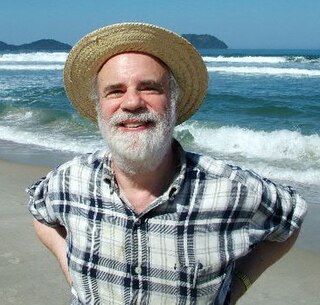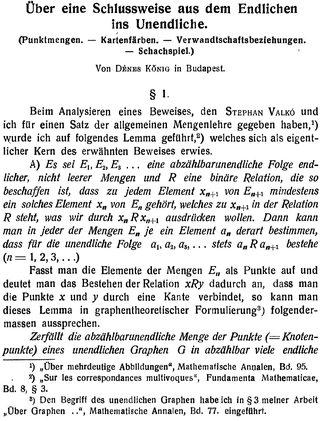In mathematics, particularly set theory, a finite set is a set that has a finite number of elements. Informally, a finite set is a set which one could in principle count and finish counting. For example,

Gödel's completeness theorem is a fundamental theorem in mathematical logic that establishes a correspondence between semantic truth and syntactic provability in first-order logic.
In logic, the law of excluded middle states that for every proposition, either this proposition or its negation is true. It is one of the so-called three laws of thought, along with the law of noncontradiction, and the law of identity. However, no system of logic is built on just these laws, and none of these laws provides inference rules, such as modus ponens or De Morgan's laws.
Mathematical logic is the study of formal logic within mathematics. Major subareas include model theory, proof theory, set theory, and recursion theory. Research in mathematical logic commonly addresses the mathematical properties of formal systems of logic such as their expressive or deductive power. However, it can also include uses of logic to characterize correct mathematical reasoning or to establish foundations of mathematics.
In the philosophy of mathematics, constructivism asserts that it is necessary to find a specific example of a mathematical object in order to prove that an example exists. Contrastingly, in classical mathematics, one can prove the existence of a mathematical object without "finding" that object explicitly, by assuming its non-existence and then deriving a contradiction from that assumption. Such a proof by contradiction might be called non-constructive, and a constructivist might reject it. The constructive viewpoint involves a verificational interpretation of the existential quantifier, which is at odds with its classical interpretation.
In logic and mathematics, proof by contradiction is a form of proof that establishes the truth or the validity of a proposition, by showing that assuming the proposition to be false leads to a contradiction. Proof by contradiction is also known as indirect proof, proof by assuming the opposite, and reductio ad impossibile. It is an example of the weaker logical refutation reductio ad absurdum.

Saul Aaron Kripke was an American philosopher and logician in the analytic tradition. He was a Distinguished Professor of Philosophy at the Graduate Center of the City University of New York and emeritus professor at Princeton University. Since the 1960s, Kripke has been a central figure in a number of fields related to mathematical logic, modal logic, philosophy of language, philosophy of mathematics, metaphysics, epistemology, and recursion theory. Much of his work remains unpublished or exists only as tape recordings and privately circulated manuscripts.
In classical deductive logic, a consistent theory is one that does not lead to a logical contradiction. The lack of contradiction can be defined in either semantic or syntactic terms. The semantic definition states that a theory is consistent if it has a model, i.e., there exists an interpretation under which all formulas in the theory are true. This is the sense used in traditional Aristotelian logic, although in contemporary mathematical logic the term satisfiable is used instead. The syntactic definition states a theory is consistent if there is no formula such that both and its negation are elements of the set of consequences of . Let be a set of closed sentences and the set of closed sentences provable from under some formal deductive system. The set of axioms is consistent when for no formula .

Kőnig's lemma or Kőnig's infinity lemma is a theorem in graph theory due to the Hungarian mathematician Dénes Kőnig who published it in 1927. It gives a sufficient condition for an infinite graph to have an infinitely long path. The computability aspects of this theorem have been thoroughly investigated by researchers in mathematical logic, especially in computability theory. This theorem also has important roles in constructive mathematics and proof theory.
In mathematical logic, sequent calculus is a style of formal logical argumentation in which every line of a proof is a conditional tautology instead of an unconditional tautology. Each conditional tautology is inferred from other conditional tautologies on earlier lines in a formal argument according to rules and procedures of inference, giving a better approximation to the natural style of deduction used by mathematicians than to David Hilbert's earlier style of formal logic, in which every line was an unconditional tautology. More subtle distinctions may exist; for example, propositions may implicitly depend upon non-logical axioms. In that case, sequents signify conditional theorems in a first-order language rather than conditional tautologies.
Kripke semantics is a formal semantics for non-classical logic systems created in the late 1950s and early 1960s by Saul Kripke and André Joyal. It was first conceived for modal logics, and later adapted to intuitionistic logic and other non-classical systems. The development of Kripke semantics was a breakthrough in the theory of non-classical logics, because the model theory of such logics was almost non-existent before Kripke.
In mathematical logic, the disjunction and existence properties are the "hallmarks" of constructive theories such as Heyting arithmetic and constructive set theories (Rathjen 2005).
In mathematical logic, Heyting arithmetic is an axiomatization of arithmetic in accordance with the philosophy of intuitionism. It is named after Arend Heyting, who first proposed it.
Constructive set theory is an approach to mathematical constructivism following the program of axiomatic set theory. The same first-order language with "" and "" of classical set theory is usually used, so this is not to be confused with a constructive types approach. On the other hand, some constructive theories are indeed motivated by their interpretability in type theories.

Markov's principle, named after Andrey Markov Jr, is a conditional existence statement for which there are many equivalent formulations, as discussed below.
In constructive mathematics, Church's thesis is an axiom stating that all total functions are computable functions.
In intuitionistic mathematics, a choice sequence is a constructive formulation of a sequence. Since the Intuitionistic school of mathematics, as formulated by L. E. J. Brouwer, rejects the idea of a completed infinity, in order to use a sequence, we must have a formulation of a finite, constructible object that can serve the same purpose as a sequence. Thus, Brouwer formulated the choice sequence, which is given as a construction, rather than an abstract, infinite object.
In a controversy over the foundations of mathematics, in twentieth-century mathematics, L. E. J. Brouwer, a proponent of the constructivist school of intuitionism, opposed David Hilbert, a proponent of formalism. The debate concerned fundamental questions about the consistency of axioms and the role of semantics and syntax in mathematics. Much of the controversy took place while both were involved with the prestigious Mathematische Annalen journal, with Hilbert as editor-in-chief and Brouwer as a member of its editorial board. In 1920 Hilbert succeeded in having Brouwer, whom he considered a threat to mathematics, removed from the editorial board of Mathematische Annalen, the leading mathematical journal of the time.
Minimal logic, or minimal calculus, is a symbolic logic system originally developed by Ingebrigt Johansson. It is an intuitionistic and paraconsistent logic, that rejects both the law of the excluded middle as well as the principle of explosion, and therefore holding neither of the following two derivations as valid:
In intuitionistic mathematics, a species is a collection. A spread is a particular kind of species of infinite sequences defined via finite decidable properties. In modern terminology, a spread is an inhabited closed set of sequences. The notion of spread was first proposed by L. E. J. Brouwer (1918B), and was used to define the real numbers. As Brouwer's ideas were developed, the use of spreads became common in intuitionistic mathematics, especially when dealing with choice sequences and the foundations of intuitionistic analysis.










